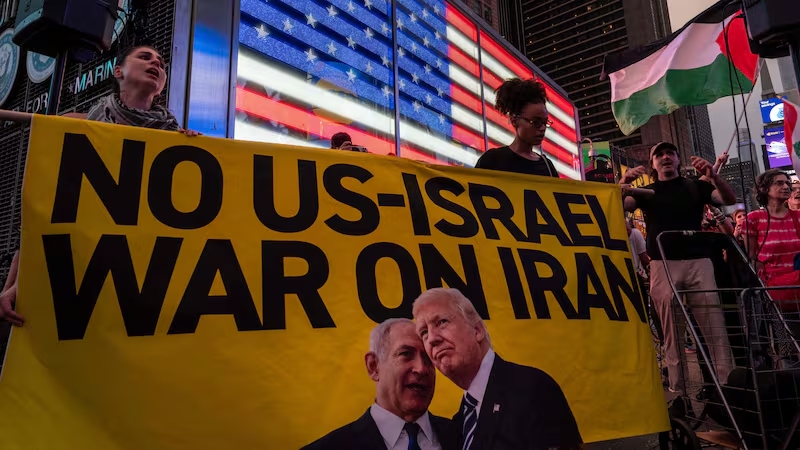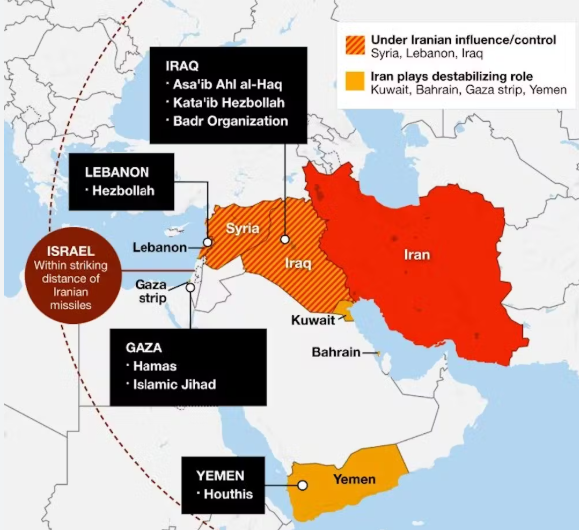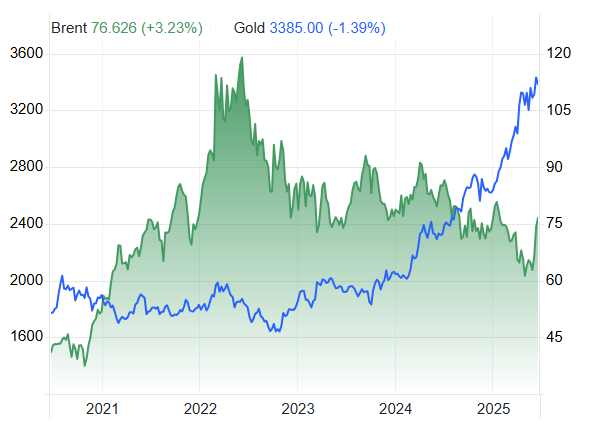The Israel/U.S. Iran offensive is not about nuclear weapons. It is about still another unwarranted proxy war. It aims at the restoration of pre-1979 Iran.

Protesters hold a banner with a message and images of U.S. President Donald Trump and Israeli Prime Minister Benjamin Netanyahu during a 'No War on Iran' rally in New York City, U.S., June 18, 2025.
Only days ago, President Trump reiterated that Iran will never have nuclear weapons. Yet, according to U.S. intelligence assessments, Iran was up to three years away from being able to produce and deliver a nuclear weapon. While Israel built its case for war, the U.S. didn’t buy it. The problem is that Trump did.
In the process, a misguided concept of Israel’s national security morphed into an even more twisted view of U.S. national security. Ironically, Iran is a member of the Non-Proliferation Treaty (NPT), which Israel shuns.
On Monday, the leaders of the G7 countries issued a joint statement stating Iran should not have nuclear weapons and affirming Israel's right to defend itself. After October 7, 2023, these countries resorted to a similar argument, which then paved the way to Israel’s genocidal atrocities in Gaza and ethnic cleansing in the West Bank.
Meanwhile, the Trump administration insisted it was working for a peaceful resolution in the U.S.-Iran talks, opposing the Netanyahu war cabinet’s unilateral military plans. Yet, by June 17, President Trump said the U.S. demanded Iran’s “UNCONDITIONAL SURRENDER.” Threatening the life of Iranian Supreme leader Ayatollah Ali Khamenei, he was considering “all options,” including a potential U.S. strike against Iran.
Reminiscent of the West’s imperialist cartels in the late 19th century, this is what the much-touted international “rules-based order” looks like in the early 21st century, when the gloves are off and might makes right at the expense of the Global South.
The deception campaign
Not so long ago, the Iran-U.S. negotiations still appeared to be promising. But expectations were revised almost overnight on Thursday June 12, when the International Atomic Energy Agency (IAEA) said Iran wasn’t complying with its nuclear obligations. That triggered a slate of diplomatic efforts to restore the UN sanctions on Tehran later this year.
Oddly, only a week before, Iran’s state broadcaster IRIB reported Iranian intelligence services had obtained a large volume of sensitive material from Israel, including documents on its secretive nuclear and strategic facilities. As international debate mounted on the IAEA compliance issues, Iranian media began releasing images of the documents related to Israel's nuclear program obtained by Tehran, claiming collusion between the IAEA and Israel.
On Friday June 13, Israel began a major military operation against Iran, including air strikes and reported covert action. Prime Minister Benjamin Netanyahu vowed to continue attacks for “as many days as it takes” presumably targeting “existential threats” posed by Iran’s nuclear program and ballistic missiles.
In a letter to the United Nations, Iran’s foreign minister described Israel’s attack as a “declaration of war,” calling on the UN Security Council to immediately address the issue.
These perilous developments, which Europe too is supporting, are taking place against the backdrop of the continuing U.S./NATO-led proxy war in Ukraine against Russia and Israel’s genocidal atrocities in Gaza and ethnic cleansing in the West Bank.
Concurrently, U.S. diplomacy, including Special Envoy Witkoff’s talks and President Trump’s personal reassurances, have served as a bilateral ploy, basically to cover for the Israeli surprise attack. Building on disinformation, the deception campaign has reaped extraordinary short-term benefits. By the same token, it is likely to undermine the U.S.’s international credibility for years to come.
Neutralizing the Axis of Resistance
Ever since the Islamic Revolution, when President Carter froze billions of dollars in Iranian assets, Washington has sought to restore the pre-1979 status quo ante in Iran. It was the Shah’s rule that made Iran safe to American capitalism in the postwar era, thanks to the U.S.-UK coup in 1953, U.S. military aid and SAVAK, Iran's dreaded secret police, partly trained by Israel.
Nonetheless, U.S. regime-change initiatives moved to a new stage during the Bush Jr. administration. Since 2003, the U.S. Army has conducted an analysis called TIRANNT (Theater Iran Near-Term) for a full-scale war with Iran.
At the turn of the 2010s, the U.S. and Israel deployed the Stuxnet virus, the world’s first offensive cyber weapon, to destroy almost a fifth of Iran’s nuclear centrifuges.
In 2015, years of challenging talks resulted in a nuclear deal (Joint Comprehensive Plan of Action, JCPOA) between Iran, the U.S., and a set of world powers. Despite Iran’s adherence to it, the Trump administration, in its anti-Obama zeal, pulled the U.S. out of the deal in 2018.
The ultimate objective has been the obliteration of the Iran-led Axis of Resistance in the region. Hence, the Biden and Trump administrations’ tacit acceptance of Israel’s obliteration of Gaza, the destruction of Hezbollah’s footholds in Southern Lebanon, the efforts to rule-and-divide in Syria and Iraq, and the bombing of the Houthis in Yemen (Figure 1).
Figure 1 Western view: Iran’s Axis of Resistance

Source: Master Strategist/Axis of Resistance, CC BY-SA
U.S.-led “normalization” vs. Chinese development
Following the first Trump administration, the Biden cabinet struggled to have Saudi leaders establish diplomatic ties with Israel. There was talk about a security deal with the U.S., modeled loosely on the U.S.-Japan mutual defense pact, with cooperation in a civilian nuclear program.
Preceded by Israel’s peace treaties with Egypt (1979) and Jordan (1994) and the Oslo Accords with the Palestinian Authority (1993-95), Biden’s “grand bargain” was predicated on Trump’s Abraham Accords (2020-2021) between Israel and the UAE and Bahrain, Morocco and Sudan, respectively.
Like most of the Middle East, Saudi Arabia seeks both U.S. and Chinese benefits. It has joined the BRICS alliance, remains one of China’s largest oil suppliers and is selling oil in multiple currencies. It is also the world’s second-largest arms importer and 74 percent of those weapons come from the U.S. That’s the leverage the U.S. administrations have tried to use to limit Riyadh’s cooperation with Beijing on trade, technology and military matters.
Unlike the U.S., Beijing has invested significantly in the Middle East, defused tensions between Iran and Saudi Arabia, unified Palestinian forces and launched a historic strategic partnership with Egypt. The launch of another Silk Road ensued after major Chinese investments in Saudi Arabian stocks and the signing of memorandums of understanding worth $50 billion with six major Chinese financial institutions.
The U.S. seeks exclusive military partnerships, whereas China builds inclusive economic alliances. Iran is the latest flashpoint of these conflicting goals.
Iran’s huge untapped oil and gas reserves
In the White House, regime change in Iran is seen as tempting, due to Iran’s huge regional economic and geopolitical importance. Connecting the Persian Gulf with the Arabian Sea, the Strait of Hormuz, is one of the world's most important oil chokepoints. Flows through the Strait make up over one-quarter of global seaborne traded oil. In addition, one-fifth of global liquefied natural gas (LNG) trade transits the Strait annually. It is Iran's insurance.
Iran is also the OPEC's fourth-largest crude oil producer and the world's third-largest dry natural gas producer. Most importantly, it holds some of the world's largest deposits of proved oil and natural gas reserves. It is these lucrative resources that have paced the West's external interventions in the country for a century (Figure 2).
Figure 2 Iran’s largest oil and natural gas fields

Source: EIA
China has exclusive rights to several Iranian oil and natural gas fields. As part of a 2016-2017 agreement, Beijing cautioned it would regard any foreign attack on these areas as attacks on its own sovereign territory. Two years later, Iran joined China’s Belt and Road (BRI) initiative. In March 2021, the two countries signed a 25-year and $400-billion strategic cooperation agreement.
Based on tanker tracking data, China imports nearly 90% of Iran’s crude oil and condensate exports, up from 25% in 2017, the year before U.S.-led sanctions were re-imposed.
Dire, direr and direst scenarios
Three years ago, the escalation of the proxy war in Ukraine drove Brent oil prices to record levels. Except for a brief spike amid Israel’s Gaza offensive, oil prices had halved from $120 to $60 in early May, even as gold continues to soar. In the past week, Israel’s attacks against Iran fueled the prices up to $77 (Figure 3).
Figure 3 Dramatic gold rallies, mild oil spikes

Source: Tradingeconomics, author, June 17, 2025
Until recently, this status quo was in line with the investment banks' base case, which is premised on a limited strike scenario. In this narrative, Iran's response stays moderate, elevated Israel/U.S.-Iran tensions will not explode and trade routes remain largely unaffected. Except for brief spikes, Brent oil won’t exceed $75 per barrel.
This status quo is now at a crossroads. When President Trump left the G7 Summit prematurely, he suggested he wasn't looking for just a ceasefire in the Middle East, but “A real end.” With further escalation, the White House is now setting the stage for a new, direr status quo.
In an elevated scenario, Iran will engage in heavier than anticipated retaliation (which has not happened), but Israel will continue its offensive and the Trump administration flirts with escalation. However, all actors still seek to avoid a full-scale regional conflict, which will become challenging as human and economic costs climb and if oil prices exceed $100.
Ignoring the sober advice of his own head of national intelligence, Tulsi Gabbard, Trump has single-handedly dragged the conflict closer to a broad and protracted conflict scenario. That has potential to involve not just Israel and Iran but the US, as evidenced by the Pentagon’s ongoing huge asset transfers into the region. In the absence of restraints, the consequent damage of regional energy infrastructure could prove extensive and result in blockages of chokepoints, such as the Strait of Hormuz. In such a scenario, oil prices could trade around $100-$150, with spikes even above $150.
It is still another unwarranted proxy war, but one in which global economic prospects would not be unaffected.
